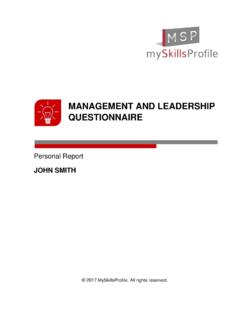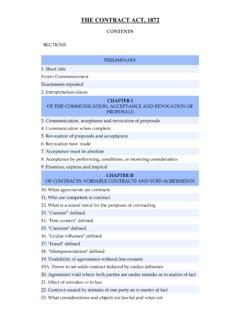Transcription of The Teacher’s Role - SAGE Publications Inc
1 1422 The teacher s RoleTeaching in a preschool or kindergarten classroom ischallenging. It is physically demanding because there is rarely amoment to sit down. It is mentally and emotionally demandingbecause it requires that you be constantly alert and alwayssearching for ways to extend the children s discoveries and enhancetheir learning. Teaching young children can be more difficult anddemanding than teaching older children! It is also tremendouslyrewarding when you see young children develop into independentand self-confident thinkers, doers, and 5/18/2006 11:52 AM Page 14 The following is a list of roles that teachers of young children mustassume in order to provide quality learning experiences.
2 Byfulfilling these roles , you will teach children to think independentlyand creatively, to ask questions and look for their own answersthrough experimenting and exploring, to become aware of theirown uniqueness and to value themselves as worthwhile humanbeings, and to get along peacefully in the world with first and most important job is to plan and prepare theenvironment for learning. Because young children learn throughplay, it is essential that you provide the materials and equipmentnecessary for meaningful play activities that support thedevelopment of multiple intelligences. The classroom and theoutdoor area must be set up with care so that the children willfind interesting, stimulating, meaningful, and challenging thingsto do in an atmosphere that is orderly, safe, and has a sense ofpurpose.
3 Young children also learn best when they feel emotionally safe andsupported. When planning your classroom, always keep in mindthe children s ethnicities, cultures, languages, and differing sure that your environment, including your books, music,posters, pictures, dolls, dramatic play props, cooking activities, andthe overall tone of your interactions, reflects a respect and concernfor each child as a unique individual and as a member of a familyand a community. In such a carefully planned learning environment, children willlearn that school is a happy, safe, and interesting place in whichthey can explore, discover, and learn about themselves and theworld around them.
4 With this belief system in place they areprepared to move forward into the more structured world of school with eager anticipation and ready for the planning and preparation are finished and children arrivefor the day, your role shifts to that of a facilitator. It is your job tomake sure that every child has the opportunity to experience15 THE teacher S 5/18/2006 11:52 AM Page 1516success and learn according to individual needs, styles, and levels ofability. Move about the classroom and the outdoor area while thechildren are playing. Watch, listen, and talk with the childrenduring their play.
5 Ask open-ended questions to help children extend their thinkingand stretch their vocabulary. Open-ended questions are thosewith many possible answers. Some examples of open-endedquestions are: What did you notice about the paint at the easel today? What do you think will happen when you put the cork in thewater? Tell me about the lemon. For additional questioning ideas, see Bloom s Taxonomy onpage moving about the learning environment, be alert for specialmoments of discovery teachable moments when a child is on thebrink of learning something new. When this happens, move closer andhelp the child take the new ideas a step or two further.
6 For example,two children have built towers with blocks and they notice that onetower is taller than the other. This is a good time to move in and begintalking with the children about ways in which the towers are the sameand ways in which they are different. Suggest measuring the towersand encourage the children to think of ways to do the might suggest using a piece of yarn, their hands, their feet, theirshoes, a tape measure, or a yardstick. Encourage children to go fromthat point to measuring other objects in the room, comparingmeasurements, and writing their results on paper. When you are working with children in this exploratory way,always remember that their learning will be less meaningful if yougive them the answer or take over the direction of the you facilitate children s learning, you are setting things upand providing materials, time, space, and encouragement so thatthey can find their own answers in their own way and in their owntime.
7 That s what early learning is all children s playtime is also a time for you to observe each childcarefully. Through careful observation of children at work and playEARLY CHILDHOOD EDUCATION GOALS, roles , AND CURRICULUM 5/18/2006 11:52 AM Page 16you can begin to see which skills they have mastered and whichskills need additional reinforcement. Your observations can giveyou insight into which intelligences are used more than others by aparticular child. They may also raise your awareness of a child scultural, linguistic, or developmental needs. These observations willhelp you plan for the next day or week.
8 If, for example, you see that a child has mastered all of the puzzlesin the classroom, make a note of that and plan to provide moredifficult puzzles the next day. If you notice that a child is callingall of the shapes in the block center squares, make a note ofthat observation and plan to spend more time with that child,mentioning the names of shapes that are encountered throughoutthe classroom. When that child chooses a block activity, you mightgo into the block center and say, I see you ve used many trianglesin your building today, as you point to the triangles. If that samechild chooses to paint circles at the easel, say, You re painting acircle.
9 By casually mentioning the names of shapes over a period ofdays and weeks and months of play, the child is likely to learn thenames of shapes easily and naturally. Anecdotal RecordsIt is helpful to keep anecdotal records of observations like thosementioned above. Make a section in a recipe-card file box witheach child s name on it. Write anecdotal notes and the date of theobservation on index cards. Be specific. For example, a goodnotation would be, Julia completed a ten-piece puzzle withoutassistance. With this notation, you know that Julia needs to beexposed to more difficult puzzles, and you can plan to providethose challenges in the days to come.
10 Vague comments like, Juliahas good eye-hand coordination are less helpful to you when youare planning new opportunities for the child. File the cards behindthe child s name in the file these observations to a collection of children s work,developmental checklists, and parent observations and you have agood overview of the child s strengths, needs, and interests. Manyteachers put such collections together into a box or set of folderscalled a portfolio. Portfolios are used for assessment and forplanning, and they enable the teacher to provide an individuallyappropriate experience for each teacher S 5/18/2006 11:52 AM Page 17 KKeeeeppiinnMMiinnddModelSocial skills such as cooperating, getting along with others, andcommunicating effectively to solve problems can be modeledthrough actions and words.















